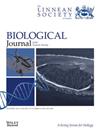Seasonality predicts variation in life history phenotypes in the livebearing fish Priapichthys annectens
IF 1.5
3区 生物学
Q3 EVOLUTIONARY BIOLOGY
引用次数: 0
Abstract
Livebearing fishes (Poeciliidae) have been used as models to test several aspects of life history theory. Previous work in these fishes showed that traits such as age and size at maturity, reproductive allocation, and number and size of offspring can each be shaped by natural selection. Life history traits can also be influenced by the environment, and in some cases, such phenotypic plasticity can also be adaptive. Resource availability in the environment can affect life history trait expression with increased resources expected to result in increased investment in reproduction. Here, we test this hypothesis in the Costa Rican livebearing fish Priapichthys annectens by quantifying life history traits and comparing trait values between populations collected during the dry season versus the wet season, periods when resource availability varies. We found that life history traits related to reproductive investment, but not the timing of reproductive events, differed between seasons. During the wet season, female body condition increased, and females invested less in reproduction, having fewer but larger offspring. Irrespective of the season, larger females gave birth to larger offspring. Finally, we found that this species utilizes a lecithotrophic strategy of provisioning eggs with nutrients being deposited in the ova prior to fertilization, and that females only carry one developing brood at a time (no superfetation). This is the first study documenting the life history of P. annectens, and it adds to a growing body of work suggesting that seasonal environmental differences can induce changes in the expression of some—but not all—life history traits.季节性预测了生育鱼颈鳞鱼生活史表型的变化
有生命的鱼类(水蛭科)被用来作为模型来检验生命史理论的几个方面。先前对这些鱼类的研究表明,成熟时的年龄和大小、生殖分配、后代的数量和大小等特征都可以通过自然选择来塑造。生命史特征也可以受到环境的影响,在某些情况下,这种表型可塑性也可以是适应性的。环境中的资源可用性可以影响生活史性状表达,资源的增加预期会导致繁殖投资的增加。在这里,我们通过量化生活史特征并比较干季和湿季(资源可用性变化的时期)收集的种群之间的特征值,在哥斯达黎加的活产鱼Priapichthys annectens中验证了这一假设。我们发现,与生殖投资相关的生活史特征,而不是生殖事件的时间,在季节之间存在差异。在雨季,雌性身体状况增加,雌性对繁殖的投入减少,后代数量少但体积大。不论季节如何,体型较大的雌性会生出体型较大的后代。最后,我们发现该物种利用一种卵磷脂营养策略,在受精前为卵子提供沉积在卵子中的营养物质,并且雌性一次只携带一个正在发育的幼崽(没有迭卵)。这是第一个记录了P. annectens生活史的研究,并且它增加了越来越多的工作,表明季节性环境差异可以诱导某些(但不是全部)生活史特征的表达变化。
本文章由计算机程序翻译,如有差异,请以英文原文为准。
求助全文
约1分钟内获得全文
求助全文
来源期刊
CiteScore
4.30
自引率
10.50%
发文量
140
审稿时长
3-6 weeks
期刊介绍:
The Biological Journal of the Linnean Society is a direct descendant of the oldest biological journal in the world, which published the epoch-making papers on evolution by Darwin and Wallace. The Journal specializes in evolution in the broadest sense and covers all taxonomic groups in all five kingdoms. It covers all the methods used to study evolution, whether whole-organism or molecular, practical or theoretical.d.

 求助内容:
求助内容: 应助结果提醒方式:
应助结果提醒方式:


